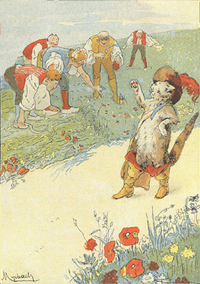Buataisí, Buataisíní, agus Búiteanna: Variations on a theme of “boot” in Irish Posted by róislín on Jul 28, 2015 in Irish Language
(le Róislín)

The usual Irish name for this character is ‘Cat i mBróga’ (aka ‘Cat na mBróg’). Hmm, why not ‘Cat i mBuataisí’? (Illustration issue de Le Maître chat ou le Chat botté de Charles Perrault en 1885, source: https://commons.wikimedia.org/wiki/File:Chatbott%C3%A91885.jpg from http://editions.bnf.fr/objets/papeterie/pap_papiers.htm)
In some previous blog posts (naisc thíos), there were passing references to the Irish words for boot (buatais) and bootees (buataisíní). Perhaps this would be a good time to look further into those words and check out “búiteanna” as well.
So let’s start with the basics, and then we’ll look at some additional usages.
For “boot,” in the basic sense of “coisbheart,” we have “buatais” [BOO-uh-tish], and the following forms:
an bhuatais [un WOO-uh-tish], the boot. The letter “b” changes to “bh” here because the word is grammatically feminine.
na buataise [nuh BOO-uh-tish-uh], of the boot (dath na buataise)
na buataisí [nuh BOO-uh-tish-ee], the boots
na mbuataisí [nuh MOO-uh-tish-ee], of the boots (dath na mbuataisí)
Sometimes, the even more familiar word “bróg” (shoe) can be translated as “boot,” so there is some flexibility in the definition, as the illustration (Cat i mBróga aka Cat na mBróg) shows. Generally (but not always), when “bróg” means “boot,” there seems to be further description that would suggest heavier footwear. Examples include “bróga troma” (heavy boots) or “bróga tairní” (hobnailed boots, lit. “nailed shoes” or “shoes of nails”). What’s that “hob” part of “hobnailed” all about anyway? — ábhar blag eile, is dócha.
And now, “bootees,” that is, baby’s bootees, not the “bootees” one might shake while dancing (at least according to K. C. and the Sunshine Band). And not a pirate’s booty, which has the “-ies” ending in the plural, and which in Irish would typically be “creach.”
an buataisín, the bootee. Note that the word is now masculine, because of the “-ín” ending, so just a regular broad “b” here
an bhuataisín, of the bootee (dath an bhuataisín)
na buataisíní, the bootees
na mbuataisíní, of the bootees (dath na mbuataisíní)
And finally, we have the “boot of the car,” at least in Ireland and Britain.
an búit [almost like “boot” in English but with the broad Irish “b” and the slender Irish “t”, which has a slight “tch” quality to it, so, approximately, “un bootch”].
an bhúit [un wootch], of the boot (claibín an bhúit)
na búiteanna [nuh BOOTCH-uh-nuh], the (car) boots
na mbúiteanna [nuh MOOTCH-uh-nuh], of the (car) boots (lán na mbúiteanna de bhuataisíní agus de bhuataisí). And that tongue-twisterish phrase means “the full of the (car) boots of bootees and boots.” And if the boots and bootees have been obtained through plundering or looting, we would have boots-full of boots and bootees booty!
So, what to say if you’re an American and generally refer to the “trunk” of the car? Most Irish sources will tell you it’s “búit” but “trunc” is increasingly recognized, at least in the Irish-speaking diaspora. At least, the American part of it. My guess is that the Australian part of the diaspora sticks to “búit.” The older Irish dictionaries generally don’t mention cars at all when discussing “trunks”. There are lots of other words for “trunk,” besides “trunc” for clothes and elephants and (formerly, I suppose) phone calls (truncghlaonna, which could also be “cianghlaonna“). Other “trunk” words include “colainn” or “cabhail” for the body, “stoc” for the body or for trees, “tamhan” also for trees (and it also means “stock” or “stem”), and “mór” (lit. “big”) for roads (“mórbhóithre,” and why were they “trunk” anyway? Ábhar blag eile!). But none of the other words for “trunk” (that is, aside from “trunc” itself) have any connections to car boots /trunks
And what to say if you’re an American talking to another American in Irish but in America with American frames of reference? Búit nó trunc? Use your judgment, I assume. It’s kind of like the “first floor/ground floor” dilemma. If you’re speaking Irish in America do you say “an chéad urlár” when in your mind it’s “an dara hurlár“? That question has me mildly, um, floored <fuaim ochaidh>! We can always use “urlár na talún” for “ground floor,” to be clear, but then is the second floor really the third floor? Or vice versa? Bhuel , sin an iomarca don bhlagmhír seo. B’fhéidir am éigin eile. SGF — Róislín
PS: Sorry, couldn’t really get into some additional boot-related vocabulary here, like “bútáil” and “athbhútáil” for reasons of space. Maybe yet another blog post sa todhchaí.
PSS: Kudos to anyone who can write in and tell us what “drár ceathrún” has to do with today’s topic, however marginal the connection.
Naisc:
https://blogs.transparent.com/irish/treoir-don-treoir-a-guide-to-the-guide-for-pronunciation/, Treoir don Treoir: A Guide to the Guide (for Pronunciation). Posted on 25. Jul, 2010 by róislín in Irish Language (passing reference to bootees)
https://blogs.transparent.com/irish/ag-seinm-uirlisi-ceoil-o-alpchorn-go-xileafon-alpenhorn-to-xylophone-in-irish-pt-4-triantan-go-xileafon/, Ag seinm uirlisí ceoil, ó alpchorn go xileafón (Alpenhorn to Xylophone in Irish): Pt. 4: Triantán go xileafón. Posted on 29. Mar, 2015 by róislín in Irish Language (passing reference to “boots”)

Build vocabulary, practice pronunciation, and more with Transparent Language Online. Available anytime, anywhere, on any device.




Leave a comment: